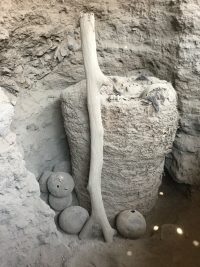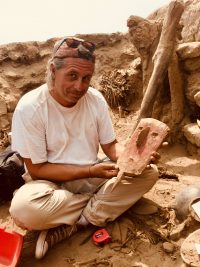 Researchers from the Université Libre de Bruxelles’s Center for Archaeological Research (CReA-Patrimoine) have discovered a mummy bundle in nearly pristine condition at the archaeological site of Pachacamac about 25 miles southeast of Lima, Peru. Preliminary analysis based on the layers, the tomb style and its location indicate it dates to 1000-1200 A.D. A sample from the bundle is in the process of being radiocarbon dated now.
Researchers from the Université Libre de Bruxelles’s Center for Archaeological Research (CReA-Patrimoine) have discovered a mummy bundle in nearly pristine condition at the archaeological site of Pachacamac about 25 miles southeast of Lima, Peru. Preliminary analysis based on the layers, the tomb style and its location indicate it dates to 1000-1200 A.D. A sample from the bundle is in the process of being radiocarbon dated now.
Pachacamac was founded around 200 A.D. and existed until the arrival of the Spanish. The archaeological site has the remains of monumental buildings — three major temple step pyramids, later step pyramids believed to be palaces for the secular rulers — and cemeteries, but has been severely damaged by looters and the elements. Because of all this damage, the discovery of so intact a mummy bundle in situ is extremely rare.
The excavation was part of the Ychsma project, named after the indigenous people of the area. After nine weeks of work, this year’s dig was almost over when the team discovered the bundle in large structure believed to be a sanctuary to the ancestors. The sanctuary had been used extensively by the pre-Inca residents of Pachacamac for funerary purposes and was studded with tombs and mummies. Most of the burial chambers were emptied out in the wake the Spanish conquest and what the looters didn’t get, water infiltration did.
 They had only found a few funerary offerings during the previous nine weeks, wooden false heads once part of mummy burials, pottery, most notably groups of Spondylus shells and beads. They were imported from Ecuador and were expensive trade items. They also had great religious significance as symbols of fertility and abundance associated with the waters brought in by El Niño. The team was pleased with these finds and never expected to discover an intact burial chamber holding an intact mummy in its intact bundle.
They had only found a few funerary offerings during the previous nine weeks, wooden false heads once part of mummy burials, pottery, most notably groups of Spondylus shells and beads. They were imported from Ecuador and were expensive trade items. They also had great religious significance as symbols of fertility and abundance associated with the waters brought in by El Niño. The team was pleased with these finds and never expected to discover an intact burial chamber holding an intact mummy in its intact bundle.
It was carefully wrapped with protective materials on site and transported to the laboratory where researchers will have the opportunity to study it non-invasively without removing the bundle. They plan to use X-rays, axial tomography and an assortment of imaging methods to create a 3D reconstruction of the mummy and its wrap. The reconstruction will allow them to explore the bundle, any artifacts placed inside of it and the mummy itself. Its burial position will be visible, and if all goes well, a full examination of the individual’s anatomy — age, gender, illnesses, overall health, maybe even cause of death.
The Ychsma project excavations this year bore fruit in other significant ways too.
The other structures that were excavated are also related to worship: the first one, an Inca monument intended to host pilgrims and rituals, was built in several phases, each identified with a series of offerings such as seashells and precious objects. The last structure explored was probably one of the ‘chapels’ for foreign pilgrims, referred to by Spanish monk Antonio de la Calancha in his 17th-century description of the site. There, the excavations also uncovered many ‘foundation’ offerings, including vases, dogs, and other animals, as well as a platform with a hole in the centre, where an idol was likely placed. The complex appears to have been designed around this idol, involved in religious activities with pilgrims.
According to researchers, all these discoveries indicate that Incas made considerable changes to the Pachacamac site, in order to create a large pilgrimage centre on Peru’s Pacific coast. “Deities and their worship played a major part in the life of Pre-Colombian societies,” concludes Peter Eeckhout. “The Inca understood this very well, and integrated it into how they wielded their power. By promoting empire-wide worship, they contributed to creating a common sense of identity among the many different peoples that made up the empire. Pachacamac is one of the most striking examples of this.”
I wonder what the stick was for? Did it use to poke out above the ground?